Related Research Articles

Woodford County is a county located in the U.S. state of Kentucky. As of the 2020 census, the population was 26,871. Its county seat is Versailles. The area was home to Pisgah Academy. Woodford County is part of the Lexington-Fayette, KY Metropolitan Statistical Area. It is located in the center of the Bluegrass region of Kentucky.

Logan County is a county in the southwest Pennyroyal Plateau area of Kentucky, United States. As of the 2020 census, the population was 27,432. Its county seat is Russellville.

Monroe County is located in the Arkansas Delta in the U.S. state of Arkansas. The county is named for James Monroe, the fifth President of the United States. Created as Arkansas's 20th county on November 2, 1829, Monroe County is home to two incorporated towns and three incorporated cities, including Clarendon, the county seat, and Brinkley, the most populous city. The county is also the site of numerous unincorporated communities and ghost towns.

Logan County is a county located in the U.S. state of Arkansas. As of the 2020 census, the population was 21,131. Its two county seats are Booneville and Paris.

Calhoun County is a county located in the south central part of the U.S. state of Arkansas. As of the 2020 census, the population was 4,739, making it the least populous county in Arkansas. The county seat is Hampton. Calhoun County is Arkansas's 55th county, formed on December 6, 1850, and named for John C. Calhoun, a Vice President of the United States.

Pine Bluff is the tenth-most populous city in the US state of Arkansas and the county seat of Jefferson County. It is the principal city of the Pine Bluff Metropolitan Statistical Area and part of the Little Rock-North Little Rock-Pine Bluff Combined Statistical Area. The population of the city was 41,253 in the 2020 census.

Paris is a city in Logan County, Arkansas, United States, and serves as the county seat for the northern district of Logan County; its southern district counterpart is Booneville. Its population was 3,176 as of the 2020 U.S. Census.

Bryant is a city in Saline County, Arkansas, United States and a suburb of Little Rock. According to the 2010 Census, the population of the city was 16,688. It is part of the Central Arkansas region.

Forrest City is a city in St. Francis County, Arkansas, United States, and the county seat. It was named for General Nathan Bedford Forrest, a notable Confederate war hero who later became the first Grand Wizard of the Ku Klux Klan. Shortly after the end of the Civil War, he had a construction crew camped here, who were completing a railroad between Memphis and Little Rock. The population was 15,371 at the 2010 census, an increase from 14,774 in 2000. The city identifies as the "Jewel of the Delta".

Anna is the largest city and retail trade center in Union County, Illinois, United States. Located in Southern Illinois, its population was 4,303 at the 2020 United States Census, a decline from 5,135 in 2000. It is known for being tied to its close neighbor Jonesboro, together known as Anna-Jonesboro, and of which the main public high school for the two towns is named. Anna is known for the Choate Mental Health and Development Center, a state facility that opened in 1869.
Sundown towns, also known as sunset towns, gray towns, or sundowner towns, were all-white municipalities or neighborhoods in the United States. They were towns that practice a form of racial segregation by excluding non-whites via some combination of discriminatory local laws, intimidation or violence. They were most prevalent before the 1950s. The term came into use because of signs that directed "colored people" to leave town by sundown.

Helena–West Helena is the county seat of and the largest city within Phillips County, Arkansas, United States. The current city was consolidated, effective January 1, 2006, from the two Arkansas cities of Helena and West Helena. Helena is sited on lowlands between the Mississippi River and the eastern side of Crowley's Ridge. West Helena is located on the western side of Crowley's Ridge, a geographic anomaly in the typically flat Arkansas Delta. The Helena Bridge, one of Arkansas' four Mississippi River bridges, carries U.S. Route 49 across to Mississippi. The combined population of the two cities was 15,012 at the 2000 census and at the 2010 census, the official population was 12,282.
Chismville is an unincorporated community in Washburn Township, Logan County, Arkansas, United States. It is located where Highway 217 terminates at Highway 23.
The following is a timeline of the history of the city of Little Rock, Arkansas, US.

The Dr. Stephen H. Chism House is a historic house in rural Logan County, Arkansas north of Booneville, on the east side of Arkansas Highway 23 about 0.5 miles (0.80 km) south of its junction with Arkansas Highway 217. A two-story log dogtrot house, it has two log pens flanking an open breezeway and a gable roof for cover. Built about 1844–45, it is believed to be the oldest log building in the county. The Arkansas Archives have a negative of the home. Log Builder Paul Glidewell completed the complete restoration of the house in late 2013.
Hopefield was a small community on the Mississippi River in Crittenden County, Arkansas. Its location is near or included within the current limits of the city of West Memphis, Arkansas. It was a ferry crossing point to Memphis, Tennessee, and was served by an east-west rail line built by the Memphis and Little Rock Railroad that eventually became a mainline of the Chicago, Rock Island and Pacific Railway. During the American Civil War General Stephen Hurlbut had the town burned to combat rebel activity. It was rebuilt, hit by a series of Yellow Fever epidemics, and diminished by erosion. Hopefield Chute, an Ox Bow also called Dacus Lake, and Hopefield Lake are in the area, as well as some remains. G. W. Watson moved there.

African Americans have played an essential role in the history of Arkansas, but their role has often been marginalized as they confronted a society and polity controlled by white supremacists. As slaves in the United States, they were considered property and were subjected to the harsh conditions of forced labor. After the Civil War and the passage of the 13th, 14th, and 15th Reconstruction Amendments to the U.S. Constitution, African Americans gained their freedom and the right to vote. However, the rise of Jim Crow laws in the 1890s and early 1900s led to a period of segregation and discrimination that lasted into the 1960s. Most were farmers, working their own property or poor sharecroppers on white-owned land, or very poor day laborers. By World War I, there was steady emigration from farms to nearby cities such as Little Rock and Memphis, as well as to St. Louis and Chicago.
John Newton Sarber was a Republican politician and a U.S. Marshal in Arkansas during the Reconstruction era. He was a member of Arkansas's 1868 Constitutional Convention and served in the Arkansas General Assembly. Sarber was a leader in legislation establishing Arkansas's public school system, the Arkansas Industrial University, and what became Logan County, Arkansas, which was initially named Sarber County over his objections. When unreconstructed Democrats returned to power, they applied political pressure to Sarber and other carpetbaggers. Sarber resigned from the marshals and Sarber County was renamed for James Logan.

Paul M. Cobbs was a state legislator in Arkansas. He served in the Arkansas House of Representatives in 1881. He served as Clerk of the House of Representatives that term. He was a Democrat.
References
- ↑ "Encyclopedia of Arkansas". Encyclopedia of Arkansas.
- ↑ "Encyclopedia of Arkansas". Encyclopedia of Arkansas.
- ↑ Society, Arkansas Medical (June 7, 1879). "Proceedings of the Convention and Permanent Organization" – via Google Books.
- ↑ "History of Benton, Washington, Carroll, Madison, Crawford, Franklin, and Sebastian Counties, Arkansas: From the Earliest Time to the Present, Including a Department Devoted to the Preservation of Sundry Personal, Business, Professional and Private Records ; Besides a Valuable Fund of Notes, Original Observations, Etc., Etc". Higginson Book Company. June 7, 1889 – via Google Books.
- ↑ "Congressional Record: Containing the Proceedings and Debates of the ... Congress". U.S. Government Printing Office. June 7, 1877 – via Google Books.
- ↑ Bailey, Amy Kate; Tolnay, Stewart E. (May 4, 2015). Lynched: The Victims of Southern Mob Violence. UNC Press Books. ISBN 978-1-4696-2088-6 – via Google Books.
- ↑ "Census profile: Roseville township, Logan County, AR". Census Reporter.
- ↑ "Stephen H. Chism House | Preserve Arkansas".
- ↑ "Roseville, Arkansas". Vertical Files. February 25, 2020.